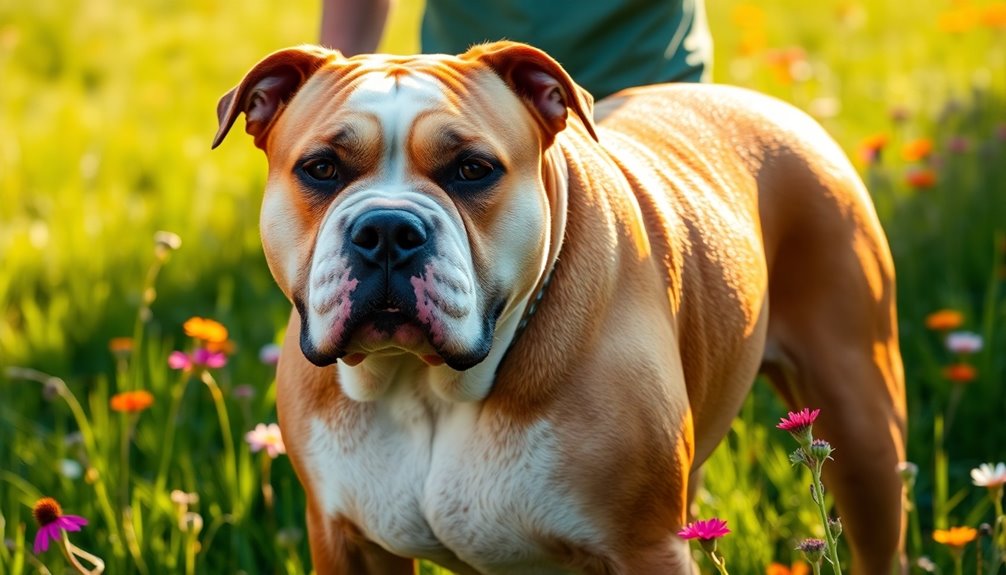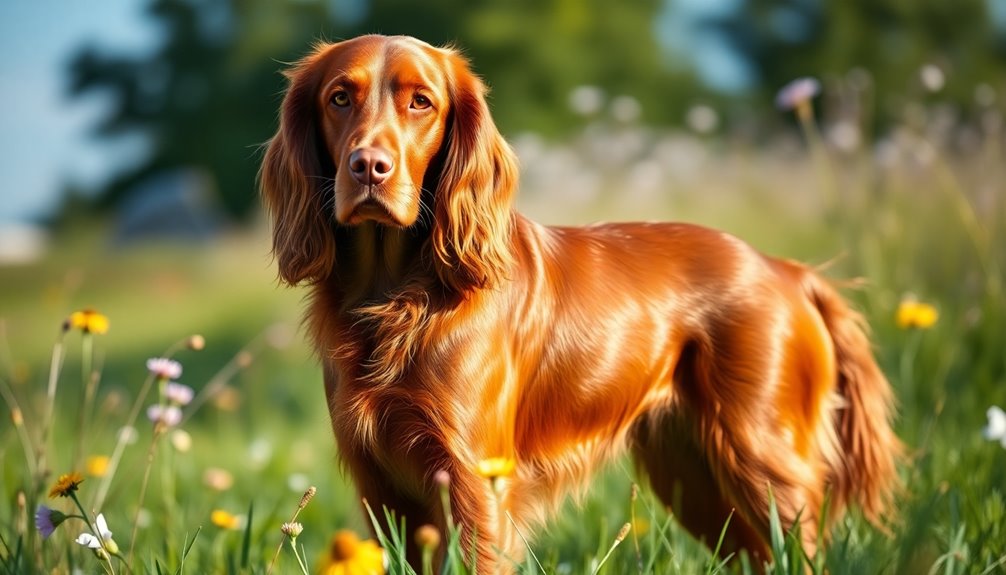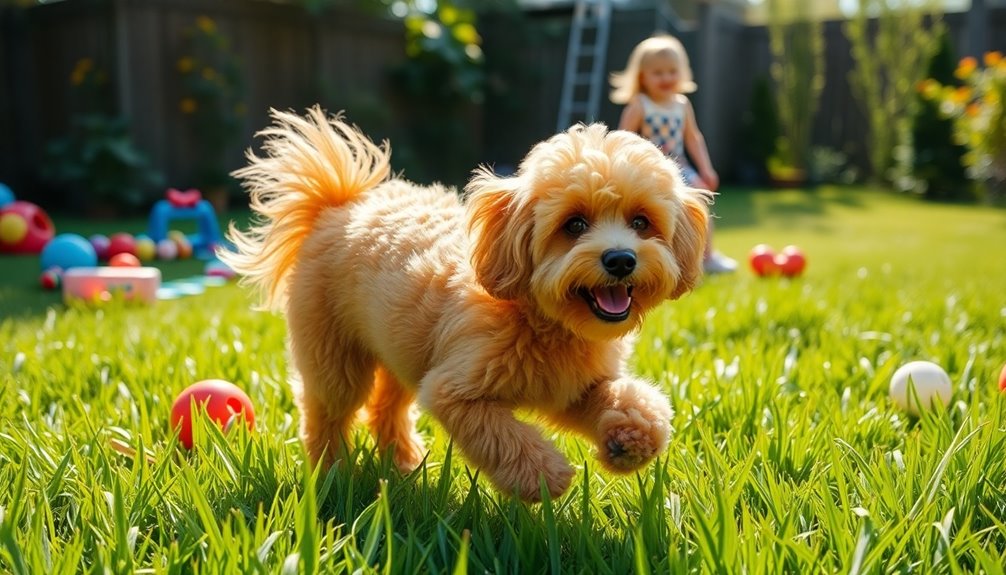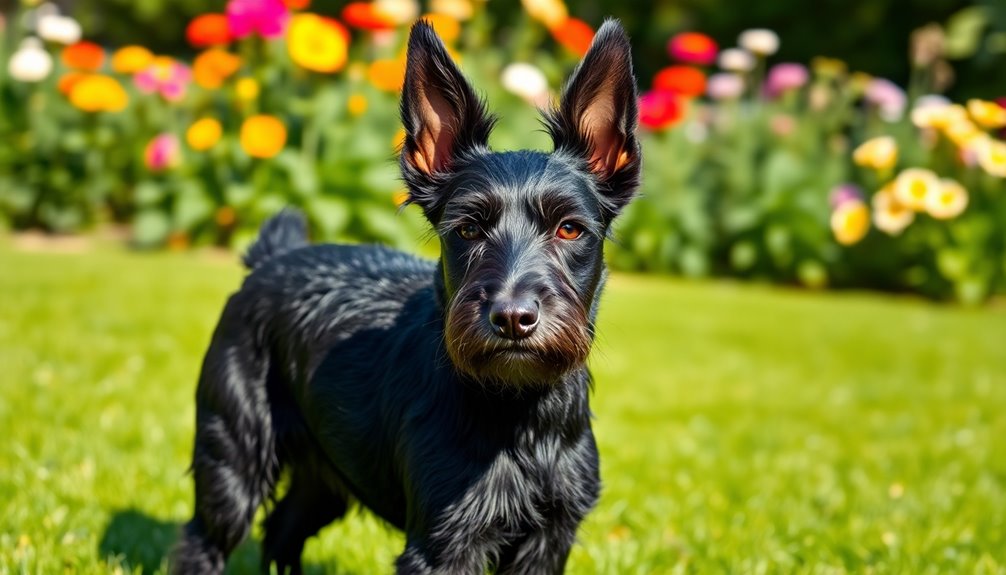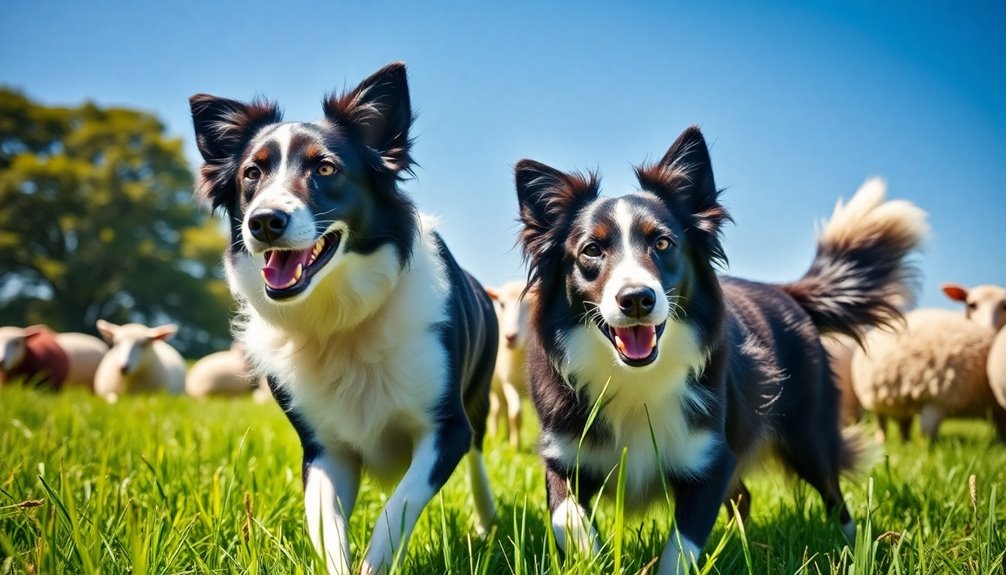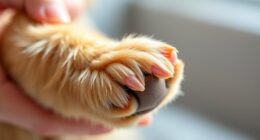American Bulldogs are the embodiment of strength, loyalty, and love, making them perfect companions for active families. With a stocky build and a powerful bite, these dogs showcase impressive physical abilities. They're incredibly loyal, especially towards children, and their affectionate nature ensures they bond deeply with your family. American Bulldogs thrive with proper training and socialization, requiring daily exercise to keep their energy in check. Regular care and attention further enhance their well-being. Discover more about these remarkable dogs' unique traits, care requirements, and why they can be the ideal addition to your home.
Key Takeaways
- American Bulldogs are known for their impressive strength and muscular build, showcasing a powerful physique that reflects their working-class origins.
- Their loyal and protective nature makes them excellent guardians, especially devoted to families and good with children.
- Affectionate companions, American Bulldogs thrive on bonding with their owners and require socialization for harmonious interactions with other pets.
- Regular exercise and mental stimulation are essential for their well-being, reflecting their high energy levels and need for engagement.
- With proper care, they can have a lifespan of 10 to 16 years, showcasing their resilience and health compared to other bulldog breeds.
Introduction
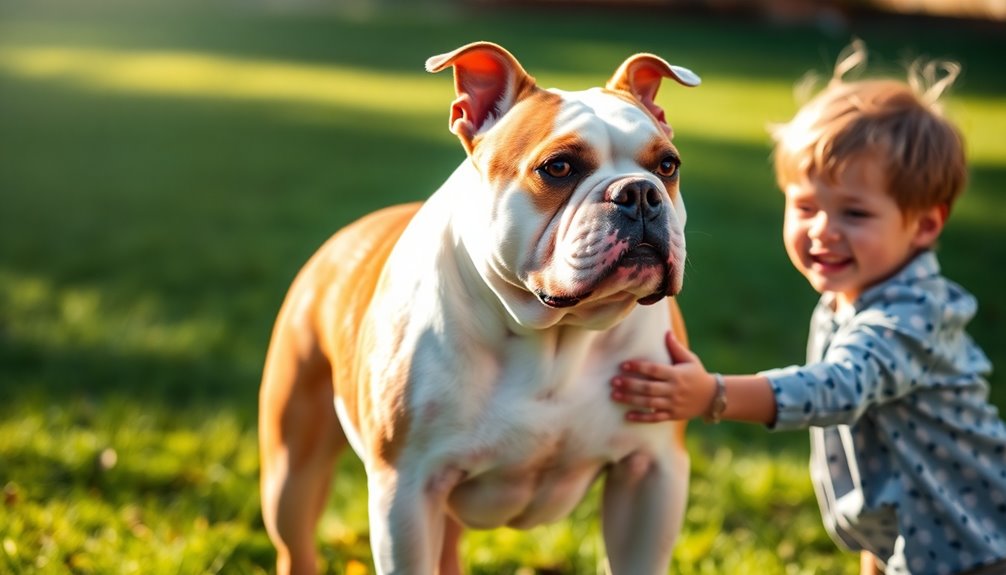
American Bulldogs are a remarkable breed known for their strength, loyalty, and affectionate nature. Standing between 20 to 28 inches tall and weighing 60 to 120 pounds, these dogs have a stocky, muscular build that exudes power. Their large, square heads and broad muzzles contribute to their impressive appearance, while their expressive almond-shaped or round eyes can be brown, blue, grey, or hazel.
With a temperament that's both loyal and brave, American Bulldogs are fantastic companions. They're especially great with families and kids, displaying a friendly and affectionate demeanor. While they may be a bit distant with strangers initially, they're always prepared to protect their loved ones when needed.
Known for their intelligence, these dogs learn quickly with consistent training, often showing a playful, clown-like side that keeps things lively. Early socialization is crucial for ensuring they develop into well-rounded adults.
Grooming is relatively easy, as they've short, smooth coats that come in various colors, including white, brindle, and shades of gray or brown. With a low-set, thick tail and medium-sized ears, their overall appearance is striking.
American Bulldogs thrive in active households, requiring regular exercise to stay healthy and happy.
History and Origin
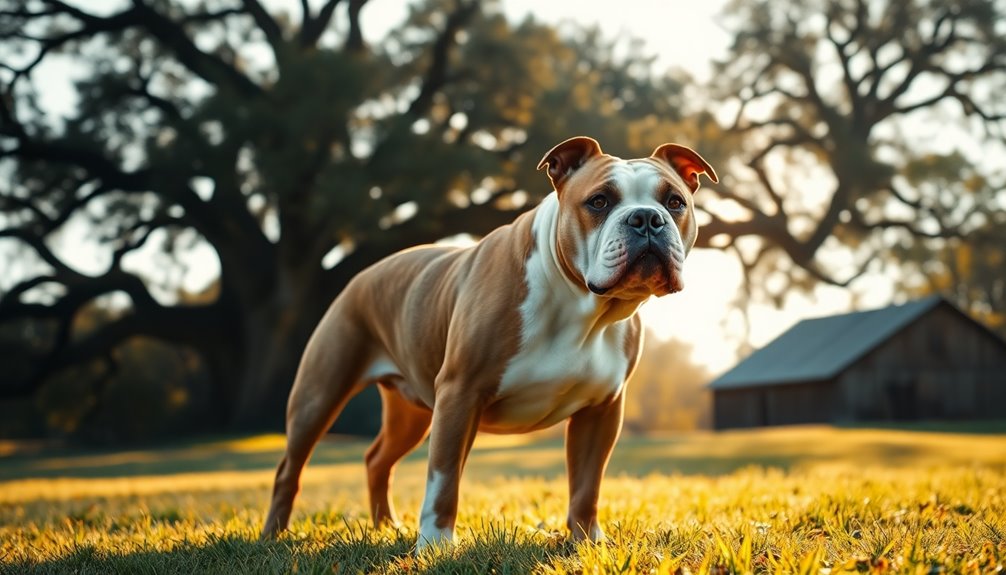
American Bulldogs trace their origins back to 17th-century England, where they were bred from English Bulldogs brought over by working-class settlers.
These dogs quickly became essential farm guardians, protecting livestock and homes in the harsh American landscape. Their adaptability allowed them to take on various roles, including controlling feral pig populations, which were introduced to the American ecosystem.
As you explore their history, you'll see how their role evolved from bullbaiting to becoming versatile protectors on farms.
Where and when the breed originated
In the 17th century, English working-class settlers brought the ancestors of today's American Bulldogs to America, primarily settling in the southern regions. These early bulldogs descended from English Bulldogs, adapted to meet the needs of American farming and ranching. As they integrated into rural life, particularly in Alabama and Georgia, they became known for their strength and reliability.
By the 19th century, the breed gained prominence in agricultural communities throughout the Southern United States, serving as effective catch-dogs. However, changes in farming practices led to a decline in their numbers during the early 20th century.
Fortunately, dedicated breeders like John D. Johnson and Alan Scott worked tirelessly to revive the breed in the late 20th century. Their efforts paid off when the American Bulldog was officially recognized in the 1980s.
The breed's foundation traces back to four main strains: Williamson, Scott, Bailey, and Johnson, each contributing to the dog's characteristics and capabilities. With roots reaching back to ancient Mastiffs and influences from the Old English Bulldog, the American Bulldog's history highlights its adaptability and enduring connection to the rural American lifestyle. Additionally, their protective instincts have made them valuable companions for families throughout history.
Farm Guardian and Protector
For centuries, American Bulldogs have served as vital farm guardians and protectors, thanks to their innate strength, agility, and protective instincts. Bred primarily for their robust build and powerful jaws, these dogs excelled in handling livestock and safeguarding property. They weren't just companions; they were integral to farm life, herding and catching cattle while playing a crucial role in hunting feral pigs in the southern states.
With their stocky physique and athletic traits, American Bulldogs were well-equipped for demanding tasks on the farm. Their courageous and alert nature made them exceptional watchdogs, forming strong bonds with their families and displaying territorial instincts that kept intruders at bay. While they can be standoffish with strangers, this behavior underscores their dedication to protecting their loved ones. Their vibrant and warm personality also contributes to their ability to forge strong family bonds, making them cherished members of the home.
Though the breed faced near extinction after World War II, dedicated breeders revived American Bulldogs, focusing on preserving their health and working abilities. Today, they continue to serve as all-purpose working dogs and loyal companions, exemplifying the qualities that made them invaluable farm guardians throughout history.
Physical Characteristics
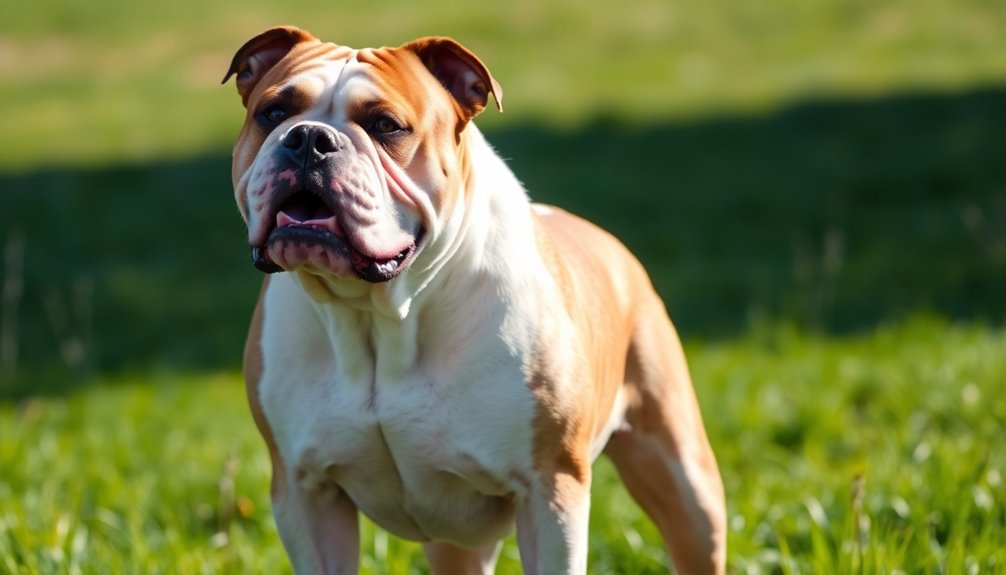
When you think about American Bulldogs, their impressive size and muscular build immediately stand out. Males typically weigh between 70-120 pounds and stand 22-28 inches tall, while females are slightly smaller at 60-100 pounds and 20-26 inches. Their broad chest and stocky frame contribute to a powerful and athletic appearance that's hard to miss. During their growth phase, healthy weight management is crucial to prevent potential joint issues as they develop.
Size, weight, and coat details
American Bulldogs are known for their impressive size and muscular build, making them a striking presence. Males typically stand between 22 to 28 inches tall, while females range from 20 to 26 inches. By the time they reach one year old, both genders usually achieve their full height, with males measuring up to 28 inches and females up to 26 inches.
In terms of weight, males generally weigh between 70 to 120 pounds, whereas females weigh 60 to 100 pounds. As puppies, you'll notice that male American Bulldogs weigh about 11.4 to 19.3 kg at three months, and females weigh 10.4 to 14.4 kg. By six months, males weigh around 50 to 75 pounds, while females range from 45 to 70 pounds.
Their coat is short, soft, and smooth, requiring minimal grooming. Though they're not hypoallergenic, their moderate shedding can be managed with regular brushing. Additionally, maintaining a healthy weight range is crucial to ensure their overall health and longevity.
Coat colors typically include white with patches of black, brindle, red, or shades of gray and brown, showcasing various combinations. These color variations don't influence their temperament, adhering to breed standards that celebrate diversity in appearance.
Muscular Build and Broad Chest
Often recognized for their impressive muscular build, American Bulldogs exhibit a strong, athletic body that commands attention. With broad, muscular shoulders and powerful legs, these dogs are built for endurance and agility. Their sturdy neck smoothly blends into the shoulders, enhancing their robust appearance. This muscular structure allows them to perform physically demanding tasks, including impressive vertical jumps of over three feet. Moreover, their high pain tolerance enables them to endure rigorous activities without displaying signs of discomfort.
A deep, broad chest is another distinctive feature of the breed. The broad back supports their muscular build, contributing to their overall athletic prowess. Powerful chest muscles play a crucial role in activities like hunting and working, showcasing their utility dog heritage.
Beyond their powerful physique, American Bulldogs possess a large, square head with a strong jaw, essential for their history as working dogs. This powerful jaw structure supports tasks such as bull-baiting and hunting, further exemplifying their strength.
Their overall athleticism is remarkable, enabling them to excel in invigorating activities like jogs, hikes, and tug-of-war games. Daily mental and physical stimulation is essential to keep them content and prevent hyperactivity, allowing you to fully appreciate their strength and loyalty.
Temperament and Personality
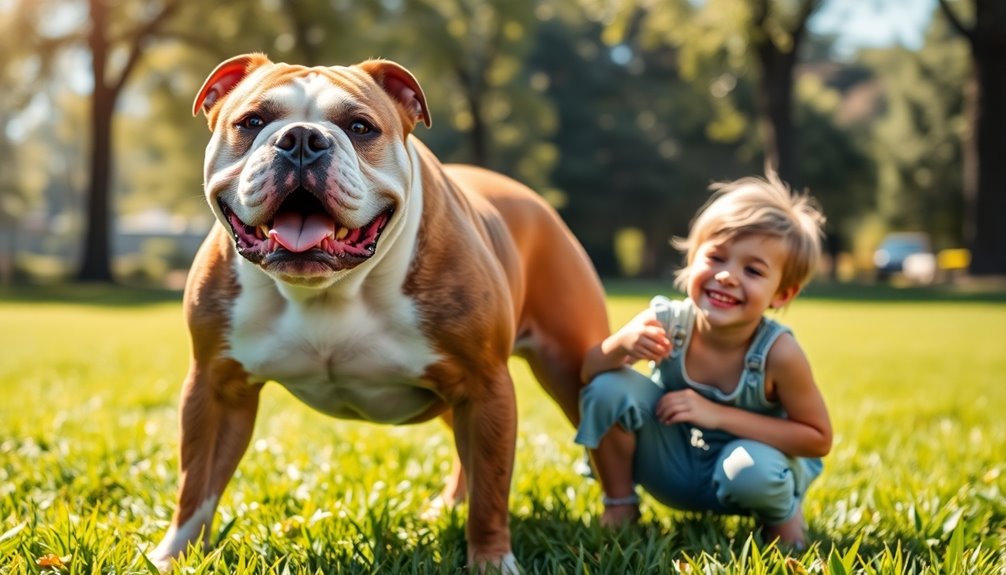
When you think about American Bulldogs, their protective and watchful nature stands out, making them excellent guardians for your home. They're not just loyal to their families; they also thrive in a family setting, especially with kids. Additionally, their dependable and big-hearted nature ensures they become cherished companions for everyone in the household. However, if you have other pets, proper socialization is key to ensuring harmony in your household.
Protective and Watchful Nature
The protective and watchful nature of American Bulldogs makes them exceptional companions for families and properties alike. Originating as working dogs on American farms, they were bred to be brave, loyal, and vigilant, descending from the Old English Bulldog.
These dogs instinctively exhibit protective behaviors, like alertness to unfamiliar sounds and people. You might notice them growling or barking at strangers, which can sometimes signal they take their protective role a bit too seriously.
They'll often position themselves between you and perceived threats, showcasing their natural suspicion of strangers. This breed's strong protective tendencies can be managed with proper training and socialization. Obedience training is crucial, using commands like *sit*, *stay*, and *come* to control their behavior.
Consistent positive reinforcement encourages calm responses to strangers, while controlled guarding exercises teach them when to be protective. Additionally, early socialization from 8 to 16 weeks is essential to help them distinguish between normal and threatening situations.
Despite their vigilance, American Bulldogs balance affection with their guarding instincts, aiming to deter rather than inflict harm. Their muscular build and confident demeanor serve as a deterrent to potential intruders, ensuring you feel safe and secure in their presence.
Suitability for families, individuals, or other pets
American Bulldogs make excellent companions for families, individuals, and even other pets, thanks to their friendly and affectionate demeanor. They're known for their gentle nature with children, often earning the title of "gentle giants." However, their high energy levels mean they need plenty of exercise and activities to stay happy. Early training and socialization are essential to integrate them smoothly into your family routine.
For individuals, their intelligence makes them easy to train, but you'll need to commit time to exercise and companionship. These dogs can't handle long periods of isolation, so regular interaction is crucial. Additionally, maintaining a routine of regular veterinary check-ups helps monitor their health and ensures they remain active and happy.
When it comes to other pets, be cautious. American Bulldogs may display territorial behavior, particularly with same-sex dogs. Early socialization helps, but they often prefer being the only dog in the household. Introducing them to smaller animals like cats requires careful planning due to their strong predatory instincts. Always ensure a safe space for any small pets and supervise interactions to maintain harmony.
Health and Lifespan
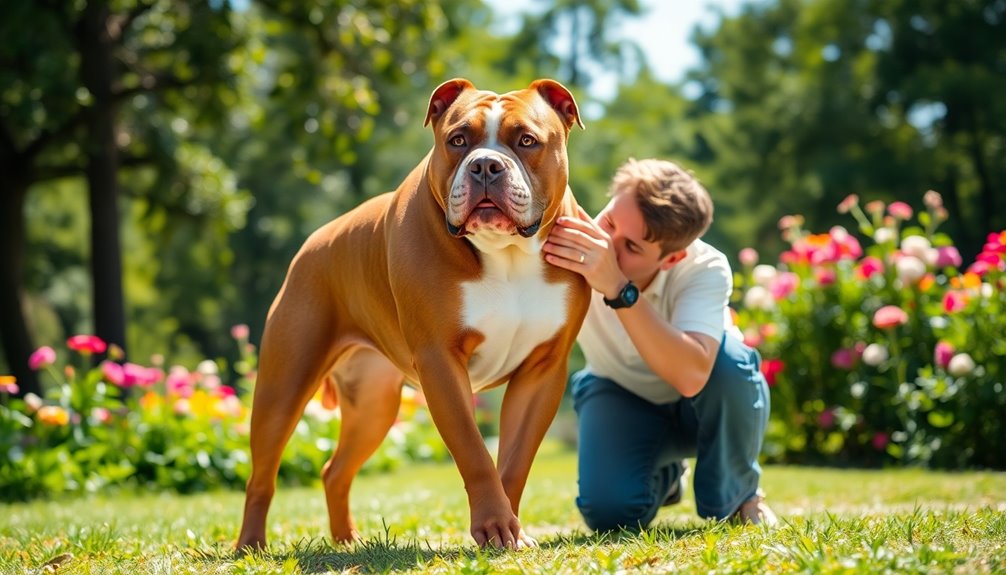
When it comes to American Bulldogs, their typical lifespan ranges from 10 to 16 years, with proper care playing a vital role in reaching the higher end of that range. However, be aware of common health concerns like hip dysplasia and obesity that can affect their quality of life. To keep your bulldog healthy, regular exercise, balanced nutrition, and vet checkups are essential. Additionally, bulldogs are prone to allergies, which can lead to various skin issues if not managed properly.
Typical lifespan of the breed
Bulldog enthusiasts often find themselves curious about their pets' lifespans, and understanding the typical lifespan of American Bulldogs reveals a range of 10 to 15 years. With proper care, many American Bulldogs can live comfortably within this range, and some even reach up to 16 years. Factors like genetics, diet, and overall care significantly influence their longevity. Additionally, American Bulldogs are known for their moderate exercise needs, which helps in maintaining their health and overall well-being.
To help your Bulldog thrive, focus on a balanced diet that meets their nutritional needs. Regular exercise is essential too, as it keeps them healthy and helps maintain an ideal weight, which prevents obesity-related issues.
Don't underestimate the importance of routine veterinary check-ups; they play a crucial role in your dog's overall healthcare.
One of the most appealing aspects of American Bulldogs is their lifespan compared to other bulldog breeds. They generally outlive English Bulldogs and French Bulldogs, making them a healthier choice.
Common health concerns or genetic predispositions
For any dog owner, being aware of common health concerns and genetic predispositions is crucial in ensuring your American Bulldog lives a long, healthy life.
This breed is prone to several joint and musculoskeletal issues, such as hip and elbow dysplasia, which can lead to arthritis. ACL injuries are also common, and maintaining a healthy weight is essential to prevent early-onset arthritis. Regular veterinary check-ups are essential for monitoring health and early detection of issues.
Neurological disorders can affect your Bulldog, too. Conditions like Neuronal Ceroid Lipofuscinosis (NCL) and Degenerative Myelopathy can cause significant mobility issues and vision loss. Watch for symptoms like rear leg weakness and loss of coordination.
Thyroid and hormonal issues are prevalent as well. Hypothyroidism can lead to dry skin, hair loss, and unexplained weight gain. These symptoms might indicate a need for veterinary attention.
Additionally, be aware of ocular problems like cherry eye and entropion. There's also a genetic predisposition to osteosarcoma, a serious bone cancer.
Lastly, due to their brachycephalic nature, American Bulldogs can experience breathing difficulties. Regular check-ups can help catch these issues early, ensuring your beloved companion remains healthy and active.
Tips for maintaining health and wellness
Maintaining your American Bulldog's health and wellness requires a balanced approach that combines proper diet, regular exercise, and consistent veterinary care.
Start by feeding high-quality dog food with real meat as the primary ingredient. Avoid fillers, artificial preservatives, and excessive carbohydrates to support their muscle mass and energy needs. Aim for a balanced, high-protein diet and feed twice a day, adjusting portions based on age, weight, and activity level. Consider adding supplements like glucosamine for joint health after consulting your vet.
Exercise is crucial; provide 1 to 2 hours of activity daily. Include daily walks of 30 to 45 minutes and adjust routines for senior dogs with shorter, low-impact activities. Mental stimulation is also essential, so incorporate puzzle toys to keep their minds engaged. Daily walks of moderate pace can greatly benefit both your Bulldog's physical and mental well-being.
Regular veterinary checkups are vital for early problem detection. Ensure your dog has fresh water, maintain dental hygiene by brushing their teeth at least three times a week, and keep their ears clean.
Lastly, create a secure, comfortable home environment, socialize early with other pets, and spend quality time together to foster a strong bond.
Care Requirements
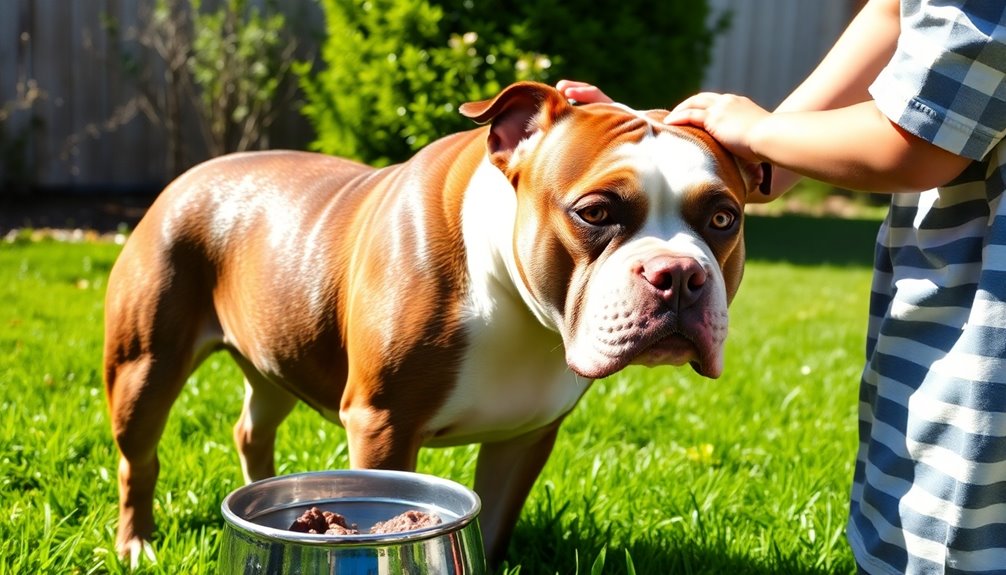
When it comes to caring for your American Bulldog, you'll need to focus on their grooming, exercise, and diet.
Regular brushing is key to managing shedding, while meeting their exercise requirements keeps them healthy and happy. Additionally, due to their high energy levels, providing a balanced diet helps maintain their energy levels and overall wellbeing.
Brushing Frequency and Techniques
Brushing your American Bulldog 2-3 times a week is essential for managing shedding and keeping their coat healthy. Regular brushing helps distribute skin oils, promoting a shiny coat while also allowing you to check for any lumps or bumps on their skin.
During seasonal changes or heavy shedding periods, you might need to brush daily to keep up with loose fur.
For brushing techniques, start with a rubber curry brush or grooming mitt to loosen dead hair and stimulate blood flow. A bristle brush works well for everyday grooming, removing dirt and spreading natural oils.
If you encounter longer coats or matted areas, consider using a slicker brush or metal comb. Always brush in the direction of hair growth to avoid skin irritation. Regular bathing with gentle dog shampoos is also important to maintain their coat health and prevent skin irritation.
When shedding is particularly heavy, a de-shedding tool can help remove the undercoat effectively.
Keep a balanced diet rich in omega-3 fatty acids to support your Bulldog's coat health. Regular grooming sessions not only enhance their appearance but also provide an opportunity to check for skin abnormalities or parasites, ensuring your American Bulldog stays healthy and happy.
Exercise requirements and energy levels
Regular exercise is crucial for keeping your American Bulldog healthy and happy. These energetic dogs require about 1.5 to 2 hours of exercise daily, so you'll want to spread this out to keep them both physically and mentally stimulated.
Daily walks should last 30 to 45 minutes, and multiple shorter walks can be just as effective as one long session. Consistency is key; try to walk at the same time each day.
You can mix up their activities by incorporating brisk walks, jogging, fetch, or interactive games. While high-impact exercises are best avoided until your pup is fully matured (around 18-24 months), strength-building activities, like using a weighted vest or dog backpack, can be beneficial. It's also important to note that daily exercise helps to manage potential health issues, such as hip dysplasia.
Don't forget about mental stimulation, which is just as important as physical activity. Engage your Bulldog with puzzle feeders, treat toys, and snuffle mats to challenge their brains and prevent boredom.
Training sessions are also great for mental exercise. For puppies, be sure to consult with your veterinarian for age-appropriate activities to avoid straining their developing joints.
Varied terrains can enhance your walks, making them more enjoyable for both of you.
Feeding tips and diet recommendations
To keep your American Bulldog thriving, a well-balanced diet is just as important as their exercise routine. Focus on high-quality, animal-based protein sources like chicken, beef, fish, turkey, lamb, duck, and eggs. Growing Bulldogs need at least 22.5% protein, while adults require around 18% to support muscle repair and immune health.
Include a moderate amount of healthy fats, aiming for at least 8.5% in their diet. Opt for fish oil, flaxseed oil, and chicken fat to provide energy and maintain a shiny coat. Healthy fat sources like fish oil can also support skin health and reduce inflammation.
Don't forget about Omega-3 fatty acids, which benefit joint health.
Incorporate complex carbohydrates like sweet potatoes, brown rice, and whole grains, while avoiding simple carbs like corn and wheat. These carbs offer fiber and help with nutrient absorption.
Adding vegetables and some fruits can further boost fiber intake.
Lastly, ensure your Bulldog gets essential vitamins (A, C, E) and minerals (calcium, phosphorus) for overall health.
Hydration is key, so provide high-moisture foods and plenty of fresh water. A balanced diet is crucial to prevent deficiencies and keep your furry friend happy and healthy.
Training and Socialization
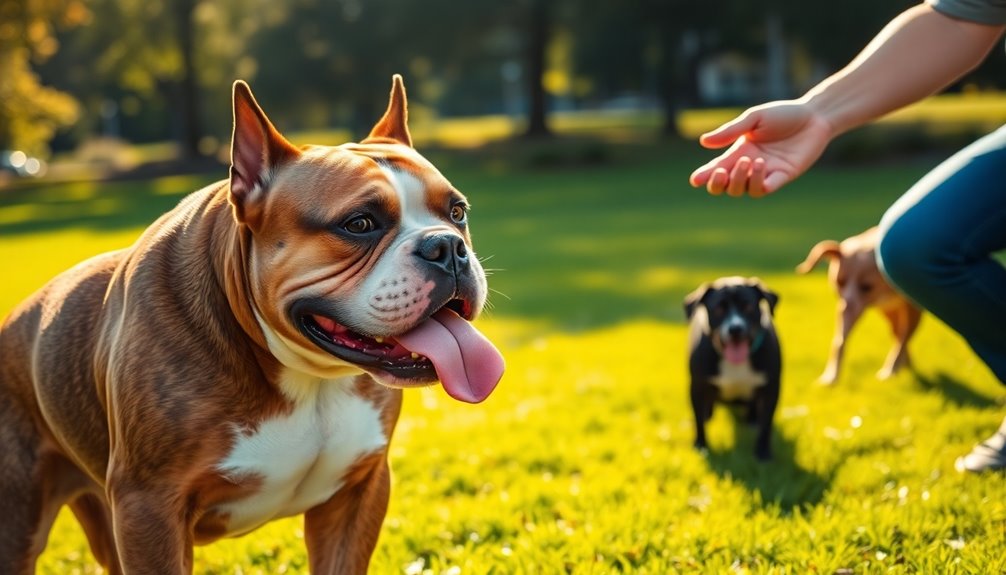
When training your American Bulldog, you'll find they're moderately responsive to commands, so using clear and consistent cues is key. Gradual introductions to new environments help prevent anxiety and leash pulling tendencies, which can be common. Providing daily exercise is also essential to help manage their high energy levels and reduce the likelihood of destructive behavior.
Moderately Responsive to Commands
Training an American Bulldog requires a tailored approach due to their moderate responsiveness to commands. You'll want to focus on positive reinforcement, rewarding good behavior with treats, toys, or praise to encourage repetition.
Establishing consistent routines for meals, walks, and training sessions can also enhance effectiveness. Keep training sessions short—around 5-10 minutes—to maintain your dog's focus, and mix up activities to keep it engaging. Start early with socialization to ensure your American Bulldog is comfortable with various environments and situations.
Use clear, consistent commands and avoid switching words for the same action. Pair verbal commands with hand signals for better clarity. Patience is key; repeat commands as necessary and reward correct behavior every time.
Start with basic obedience commands like "sit," "stay," and "come," before progressing to advanced commands such as "shake" or "roll over." Practice these commands in various locations to ensure your dog listens regardless of distractions.
Utilize a confined space for early training to minimize distractions and maintain a calm demeanor throughout sessions. Remember, establishing yourself as a leader is crucial for successful training, so always use positive reinforcement methods to encourage good behavior.
Gradual Introductions to New Environments
Introducing your American Bulldog to new environments is just as important as training commands. Start socializing your puppy between 3 to 14 weeks of age, a critical period for adaptability.
Begin at home, allowing your pup to explore different rooms and surfaces. Once they're comfortable, gradually take them to quiet outdoor areas like your backyard or familiar parks. Keep visits short at first, increasing the duration as your puppy gains confidence.
Always supervise interactions to ensure safety and avoid negative experiences. Use positive reinforcement techniques—like treats, praise, and toys—to reward your pup when they show curiosity in new settings. This creates positive associations, making them more eager to explore unfamiliar environments. Early exposure is essential in reducing future behavioral issues and fears, establishing a foundation for adaptability and confidence.
Bring familiar items, such as a favorite toy or blanket, to provide a sense of security. Encourage them to sniff around, gather information, and adapt to various sights and sounds.
Gradually expose your puppy to different surfaces and stimuli, ensuring a well-rounded experience. Celebrate their small victories to motivate them further.
With consistent socialization, your American Bulldog will grow into a confident and well-adjusted companion.
Leash Pulling Tendencies
Leash pulling is a common challenge many dog owners face, especially with energetic breeds like American Bulldogs. They pull for various reasons, including excitement, the desire to explore, and simply because they want to reach their destination faster. If your dog isn't trained yet, they mightn't even realize their behavior is problematic.
To curb this tendency, try changing direction every time your dog pulls. This way, they'll associate pulling with getting jerked around. Another effective tactic is to stop walking when they pull—wait for a loose leash before continuing. Use positive reinforcement by praising and rewarding them with treats when they walk nicely by your side. Consistency in these techniques will help diminish the desire to lead during walks. Additionally, regular outings to parks and pet-friendly cafes can provide valuable socialization opportunities, which may help reduce pulling behavior.
Walking at a good pace helps keep your dog engaged, matching their natural energy levels.
Ideal Living Environment
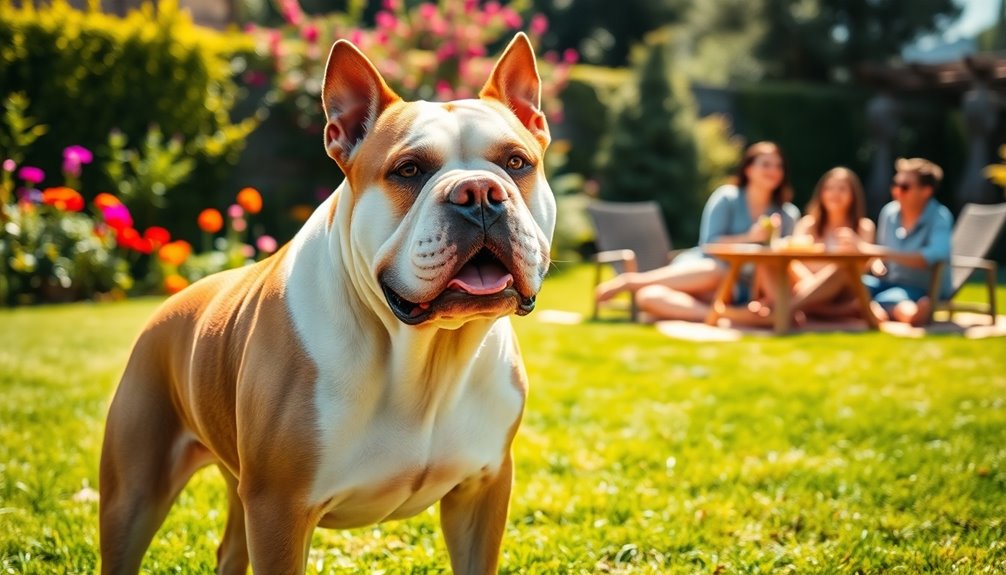
When considering an American Bulldog, you'll want a house with secure fencing to keep them safe and allow for plenty of playtime. These dogs thrive in moderate to warm temperatures, so make sure your living environment accommodates their needs. A spacious backyard is essential for their energy levels and helps prevent any destructive behavior. Additionally, they require over 1 hour of exercise daily, so having enough space for physical activity is crucial.
House With Secure Fencing
A secure fenced yard is essential for creating an ideal living environment for American Bulldogs. This breed, known for its strength and protective nature, thrives in a space where it can roam safely. The rise in coyote attacks emphasizes the need for safety in your dog's environment.
Woven wire fencing is a top choice, as it effectively keeps out predators while preventing your dog from digging or jumping out. Chain link fencing is another option, but you'll need to add bottom barriers to prevent your bulldog from escaping. Regular fence maintenance is crucial to ensure that filtration systems remain effective in preventing breaches.
Vinyl panel fencing offers durability and privacy, making it a great choice for maintaining your dog's safety. Wrought-iron fencing has a sleek appearance but may not be suitable for a bulldog with a high prey drive, as they can squeeze through the bars.
Ensure the fence is tall enough to prevent jumping, and consider adding bottom barriers to stop burrowing. Strong gates with secure locks are crucial to keep your bulldog safe from intruders.
Regular maintenance is key—check for damage, repair gaps, and clean the fence to keep it in top shape. By investing in the right fence, you provide a secure haven for your American Bulldog to thrive.
Temperature Tolerance: Moderate to Warm
Creating a secure environment for your American Bulldog goes hand in hand with ensuring it's comfortable in terms of temperature. These dogs thrive in moderate to warm climates, as their short coats don't provide ample insulation against the cold.
When temperatures dip below 45°F, your Bulldog might start feeling uncomfortable, and anything below 32°F calls for caution. At 20°F or lower, the risk of hypothermia and frostbite becomes significant, especially for a breed that struggles with cold air due to their brachycephalic features.
To keep your Bulldog happy and healthy, ensure your home maintains a warm, draft-free space. Limit their time outdoors during chilly weather to prevent discomfort and potential health issues.
If you live in a colder area, consider investing in dog sweaters or coats to provide extra warmth. Monitor your dog for signs of distress, like shivering or lethargy, and adjust their diet to support body heat maintenance without leading to obesity.
In warmer months, keep your Bulldog cool with fresh water and shade, as overheating can also pose serious risks.
Always prioritize their comfort and well-being in any season.
American Bulldogs Excel in Agility
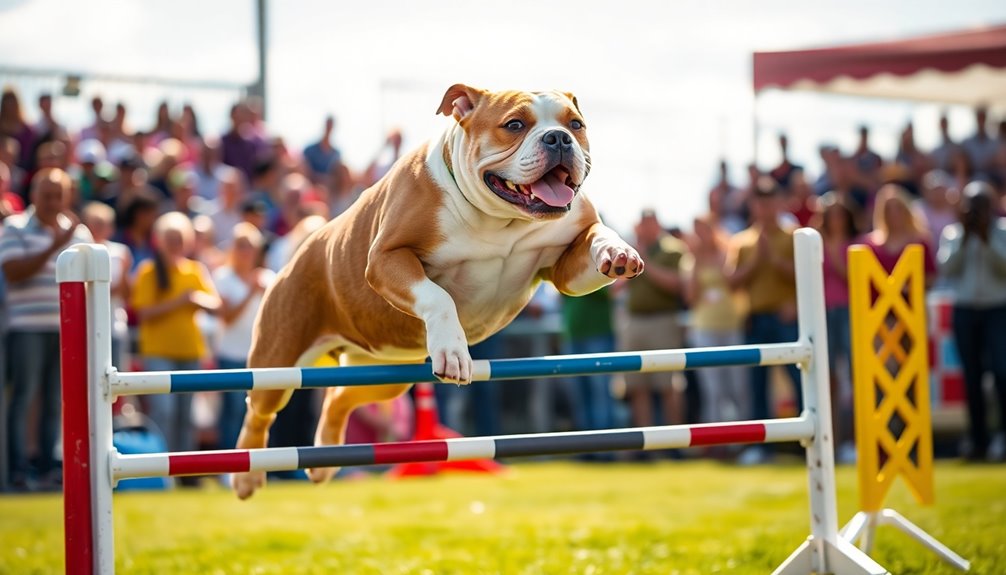
When you think of American Bulldogs, you might picture their impressive strength and agility.
Their strong bite force and athletic build not only make them a powerful presence but also highlight their capabilities in various activities, including agility courses.
Plus, their Hollywood fame as the 'bully' dog icon showcases just how versatile and engaging these dogs can be.
Strong Bite Force Measurement
American Bulldogs possess an impressive bite force, capable of generating up to 305 pounds per square inch (PSI), making them one of the strongest breeds in this regard. This powerful bite strength is a reflection of their robust physique and strong jaws, which have been measured using scientific testing devices like bite sleeves.
When considering bite strength, several factors come into play, including the dog's weight, jaw size, and the type of surface being bitten. The angle at which they bite and the surface hardness also significantly influence the measurement. Key factors affecting bite strength include the dog's weight and size of the dog's jaw, which contribute to the overall power of their bite.
To put it into perspective, the average human punch has a PSI of approximately 150, while an elite boxer's punch can reach up to 800 PSI. The American Bulldog's bite force is comparable to some powerful human punches and is stronger than many other dog breeds.
Despite their formidable bite, American Bulldogs excel in agility and can be highly trainable. Their strength allows them to participate in various activities, including obedience training and weight-pulling competitions.
Understanding their bite force helps you appreciate the balance of strength and agility in these loyal companions.
Hollywood's 'Bully' Dog Icon
With their impressive agility and athleticism, American Bulldogs have carved out a niche for themselves as Hollywood's 'bully' dog icon. Despite their stocky build, these dogs excel in various agility tasks, showcasing their remarkable speed and strength.
Originally bred for chasing stray cattle, they thrive on physical activity, making regular runs and play sessions essential for their happiness. Franco, recognized as the fastest bulldog in the country, exemplifies this athleticism with a personal record of 20.37 miles per hour.
You'll find that engaging in interactive games like fetch or agility training provides both mental and physical stimulation, keeping them sharp and eager to please.
With positive reinforcement techniques, they'll respond well to structured training, transforming into well-behaved companions. Tools like lure systems can enhance their agility, allowing them to excel in timed events such as the American Kennel Club's Fast CAT.
Take inspiration from Bronco, an American Bulldog who was celebrated as the fastest bulldog in the country after achieving an impressive speed of 20.37 miles per hour.
Their ability to participate in challenging courses highlights their competitive potential. By incorporating agility training into their routine, you not only meet their exercise needs but also strengthen your bond with these loyal, athletic companions.
Active Lifestyle Compatibility
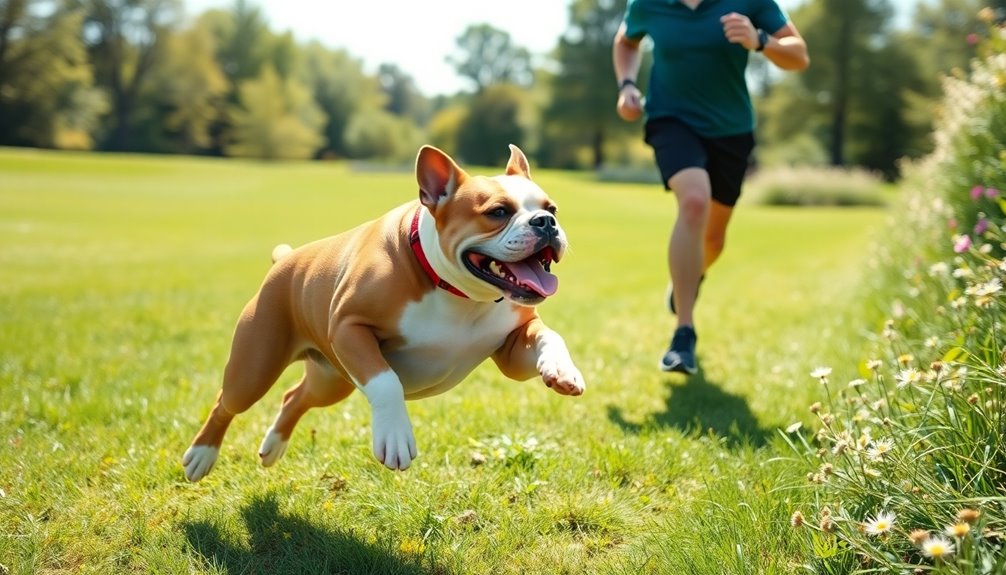
If you lead an active lifestyle, an American Bulldog can be the perfect companion. These energetic dogs thrive on daily exercise and need your commitment to keep them physically and mentally stimulated. Embracing activities like brisk walks, fetch, and agility training won't only benefit your dog but also enhance your own fitness routine. Incorporating structured routines into your daily activities will help reduce anxiety and promote a sense of security for your American Bulldog.
Energetic Companions for Active Owners
For those who lead an active lifestyle, having an energetic companion like an American Bulldog can be a perfect match. These dogs thrive in households where their owners can provide them with the physical and mental stimulation they need. They require ample space to run and play, so a secure environment is essential. American Bulldogs are also known for their strong protective instincts, making them excellent watchdogs while they enjoy outdoor activities with their families.
To keep your Bulldog happy and healthy, schedule activities during cooler parts of the day, as they're prone to heat sensitivity. Establishing a consistent routine that balances exercise and mental challenges is crucial for their well-being. You'll want to be available to meet their needs regularly, as they flourish when they've your companionship.
Training and socialization are also vital; early exposure to various environments and situations helps prevent aggressive behaviors. Using positive reinforcement techniques will strengthen your bond and encourage good behavior.
An American Bulldog's natural guarding instincts mean that they do best with experienced owners who understand their training needs.
With proper attention to their energetic disposition, you'll find an American Bulldog to be an enthusiastic partner in all your outdoor adventures. They're not just pets; they're loyal companions ready to share your active lifestyle.
Commitment to Daily Exercise
An American Bulldog thrives on a commitment to daily exercise, making it vital for active owners to integrate physical activity into their routines. These dogs require 1.5 to 2 hours of exercise each day, so you'll need to plan brisk walks, jogging, fetch, or interactive games into your schedule.
Aim for moderate to vigorous activities that keep them physically and mentally stimulated. Structured routines, like agility training or obedience exercises, are especially beneficial. Additionally, their muscular build allows them to excel in various physical activities, making it essential to challenge them regularly.
If you have a puppy, tailor the exercise to their age. For every month of their age, walk them for about five minutes, focusing on low-impact activities to protect their developing joints.
Avoid high-impact workouts until they reach 18-24 months, and consult your vet for specific guidance.
Mental stimulation is equally important, so incorporate puzzle toys and training sessions to engage their intelligent minds. These activities not only prevent boredom but also curb destructive behavior.
Lastly, as your American Bulldog ages or if health issues arise, adjust their routine to include shorter walks or low-impact options like swimming. Keeping their exercise tailored to their needs ensures a happy, healthy companion.
Frequently Asked Questions
Are American Bulldogs Good With Children and Other Pets?
If you're wondering whether American Bulldogs are good with children and other pets, the answer is generally yes, but it depends on socialization and training.
They're affectionate and patient with kids, requiring supervision to ensure safety.
When introduced properly, they can coexist well with other pets.
Early training and socialization are crucial, so make sure you teach your children how to interact gently and set boundaries for harmonious relationships.
How Much Exercise Do American Bulldogs Require Daily?
American Bulldogs need a solid amount of daily exercise to stay healthy and happy. Aim for at least 30 to 60 minutes of moderate to vigorous activity each day.
Ideally, you should provide 1.5 to 2 hours of varied exercise, like brisk walks, playing fetch, or agility training. This keeps them physically fit and mentally stimulated, preventing boredom-related behaviors.
Remember to adjust the intensity based on their age and fitness level!
What Are Common Behavioral Issues in American Bulldogs?
Common behavioral issues in dogs often include separation anxiety, destructive chewing, and aggression towards other dogs.
If you notice your dog showing signs of anxiety or chewing on furniture, it's important to address these behaviors early. Consistent training and providing mental stimulation can help reduce anxiety.
Additionally, socializing your dog with others can minimize aggression. Remember, strong leadership and clear boundaries are key to managing these challenges effectively.
Do American Bulldogs Shed a Lot?
Yes, American Bulldogs do shed moderately throughout the year, with heavier shedding during seasonal changes.
To manage this, you should brush them 2-3 times a week, or daily during heavy shedding periods. Using a bristle or rubber curry brush helps remove dead hair and distribute skin oils.
A balanced diet and regular exercise can also minimize shedding, keeping their coat healthy and reducing the amount of fur around your home.
How Can I Find a Reputable American Bulldog Breeder?
To find a reputable American Bulldog breeder, start by checking their registration with recognized kennel clubs.
Look for their experience and breed-specific affiliations. Ensure they conduct thorough health and genetic testing, avoiding common breed issues.
Investigate their breeding practices to confirm they prioritize health and temperament.
Read customer testimonials for feedback on their interactions and support.
Finally, visit the breeder to observe the conditions and the dogs they raise.
Conclusion
In conclusion, American Bulldogs embody strength, loyalty, and love, making them incredible companions for the right owner. Their unique blend of physical prowess and affectionate nature means they thrive in active households where they can engage in play and exercise. With proper training and socialization, you'll find that these dogs not only excel in agility but also form deep bonds with their families. If you're ready for a devoted friend, an American Bulldog might just be your perfect match!

